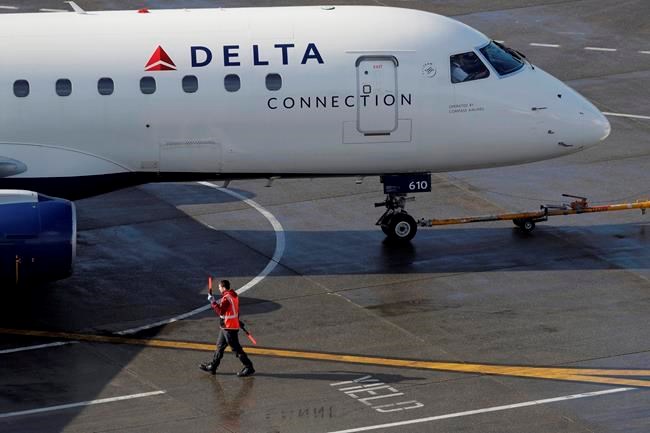The biggest and most profitable U.S. airline just posted its first quarterly loss in more than five years. Now things are going to get really bad.
Delta Air Lines Inc. reported Wednesday that it lost $534 million in the first three months of the year, when it suffered a glancing blow from the coronavirus pandemic during March.
For most of the first quarter, the virus seemed like an abstraction to many Americans. Sure, it sounded dire, but it was an ocean away. Life in the U.S. unfolded normally. The economy was humming, people took business trips and leisure flights, planes were nearly full.
Since then, the virus brought restrictions on travel and stoked fear of being trapped in a flying aluminum tube while sharing recycled air with people who might be infected. Travel has plunged about 95%.
Delta's first-quarter revenue dropped 18% from a year ago. The airline forecast a much grimmer picture for the second quarter, when the full impact of the global pandemic will be felt. Revenue is expected to plunge 90% for Delta, and things will likely to look just as bleak or worse for its competitors.
It could be a long time before travel returns to pre-outbreak levels. “Whether it's three years or two years or four years is anyone's guess,” said Delta CEO Ed Bastian.
Here are some vital signs to watch in the airline industry:
___
TRAFFIC HAS VANISHED
If there is one chart that captures the implosion of the U.S. airline industry, it might be the number of people screened each day at the nation's airports by the Transportation Security Administration.
About 2.3 million people passed through security checkpoints on March 1, unchanged from the same day last year. The numbers careened sharply lower from that point on, plunging below 100,000 by early April — a drop of about 95%. Airline officials say most of the people still flying are health care workers fighting the COVID-19 outbreak and individuals reuniting with family members.
Another telling statistic captures the emptiness of the airline planes that are still flying. Airlines for America, the industry's trade group, said that over the past week flights within the United States have carried an average of about 12 passengers — it was nearly 100 in early January, when the virus outbreak was largely limited to Asia. The average on international flights has dropped from 150 to 26 in the same time.
___
BOOKINGS TOO
Airlines have responded to the drop in traffic by
The percentage of seats sold on U.S. airline flights dropped from 80.2% in January to 13.1% in the week of April 13-19, according to Airlines for America. That includes both domestic and international flights.
Demand for future air travel in the U.S. was down 98.4% in the second week of April compared with a year earlier, according to the industry trade group.
___
FEWER FLIGHTS
With fewer passengers, it makes sense for airlines to operate fewer flights. Worldwide, there were about 111,000 commercial flights a day in early January. The numbers, which include cargo flights, started dropping sharply in March, and they are now down to about 28,000, according to tracking service Flightradar.24.
By
Delta reported a 13% drop in revenue per seat for every mile flown during the first quarter. That's a closely watched indicator in the airline business that rarely moves more than a couple points up or down in one quarter. Look for much sharper declines later this year.
___
FEDERAL AID
All the major U.S. airlines have reached agreements with the Treasury Department for billions in grants and loans to help them cover payroll costs through September. Among the biggest carriers, American Airlines will get $5.8 billion, Delta has already received half of the $5.4 billion it was promised, United Airlines will get $5 billion, and Southwest Airlines will receive $3.2 billion.
What happens to employees after the federal money runs out isn’t clear. Delta, United and American expect to be smaller when they emerge from the pandemic. They are encouraging employees to take early retirement or unpaid or partially paid leaves of absence, but analysts say layoffs are inevitable in October unless federal aid is extended.
Many international airlines have furloughed workers. They too are asking their governments for help. Richard Branson, who owns a minority stake in Virgin Atlantic, told employees this week that the carrier needs a loan from the U.K. government to survive.
___
AT LEAST FUEL IS CHEAP
Airlines, like motorists, are catching a break with cheaper fuel prices. Delta paid 12% less per gallon in the first quarter than it did a year earlier — a savings of $383 million — and that was before the latest collapse in energy prices.
But just like people who are stuck in their homes, Delta isn’t able to take full advantage of lower prices because it is
___
BUSINESS TRAVEL OR ZOOM?
Stay-at-home orders have boosted demand for video conferencing. Some forecasters think services like Zoom could steal market share from the airlines by replacing in-person meetings with virtual ones.
Airline executives say that will be true for a time, but corporate travel — a lucrative and critical part of their business — isn't going away.
“We will have some portion of travel that will move over to telecommuting," Delta's Bastian told CNBC. But, he said, “Business travel is going to come back. People need to be face-to-face, doing business together, when it's safe.”
David Koenig, The Associated Press

